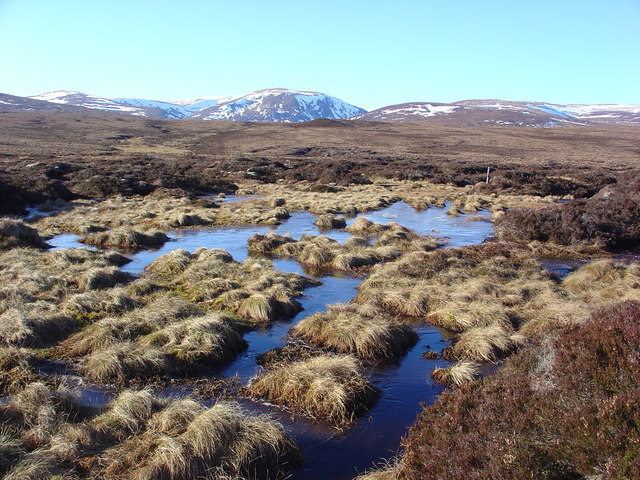
Scotland’s richest man, an oil giant, an earl, and private equity and property firms are among those developing carbon credit projects that critics say are pushing up land prices and allowing companies to “greenwash” their image, The Ferret can reveal.
With its swathes of rural land, Scotland has attracted a green rush of land investors amidst a surging carbon market. Some 63,453 hectares of land currently earmarked for forestry and peatland restoration make up an area larger than Scotland’s three biggest cities combined.
The projects could allow developers to state that nearly 14m tonnes of carbon dioxide (CO2) have been absorbed over the next century.
Scotland’s green rush has sparked a debate about how the carbon credit market boom will impact the environment and land democracy – and about whether local communities will benefit.
MSPs accused some wealthy individuals and institutions of “greenwashing” and “contributing to an unjust land market”. Scottish land values reportedly rose by 61 per cent in 2021 alone due to demand from forestry investors.
Scotland’s landowner body said carbon capture schemes were a part of a wider effort from landowners to tackle climate change. A sustainability professor agreed that carbon credits can incentivise landowners to plant trees and restore peatland, but warned that communities and others could be shut out of the process.
But land campaigner Andy Wightman called for carbon trading to be banned. He argued that only the wealthy would benefit and emissions offset by companies would not “contribute to Scotland’s net-zero ambitions nor to help cool the planet”.
Offsetting schemes generate carbon credits, which can be used by companies and organisations – or sold to others – to compensate for the emissions they release.
BP – a major carbon capture project developer – said it does not plan to rely on offsetting to meet its 2030 net zero aims.
The Ferret’s exclusive analysis is the first in a three-part special report into carbon credits. We also revealed the firms which, having poured billions of pounds into fossil fuels, are now among those buying up Scottish carbon credits.
Nearly 560,000 credits produced by Scottish projects have been sold to date, with each credit theoretically cancelling out one tonne of CO2 released into the atmosphere.
Scotland’s largest carbon credit developers
The Ferret looked at the developers of all the Scottish projects voluntarily listed on the peatland and woodland carbon codes. Just a small fraction of the credits produced – and thereby the amount of carbon the projects will absorb – have so far been validated by a third party.
The largest developer of Scotlands’ carbon capture projects is the Edinburgh-based Scottish Woodlands, which is developing 9,075ha for forestry and 252ha for peatland restoration. Scottish Woodlands is “an employee-owned company that grew out of a woodland owners’ cooperative” and has a £100m annual turnover, according to its website.
A carbon capture project management firm, Durham-based Forest Carbon, manages 6,027ha of woodland and 1,620ha of peatland. The company's co-owners previously ran forestry and peatland organisations.
Wildland, which is ultimately owned by the Danish firm Heartland A/S, holds 6,569ha of forestry sites and 229ha of peatland. The man behind both companies, Anders Povlsen, is thought to be Scotland’s largest landowner and richest man.
With around 89,000 hectares across Highland 12 estates, he has an ambitious 200-year plan to rewild northern Scotland. The Danish fashion mogul is worth £6.5bn – up £500m from 2021 – according to The Sunday Times Rich List.
The BP Exploration Operating Company, a BP subsidiary, is developing 4,802ha of woodland and four of the top 20 largest Scottish carbon capture sites. While the oil giant would be able to claim more than 1.2m t CO2e in offset emissions, BP told The Ferret it “does not plan to rely on offsetting to meet our 2030 net zero aims.”
“We have been involved in woodland regeneration in Scotland for decades, helping to plant millions of native trees, enhancing biodiversity and improving community access and we’re very proud of our long-established partnerships and projects,” said a spokesman.
“We believe that both natural and technological emissions reductions and removals are critical to reaching the Paris goals.”
In July, BP was accused of dumping thousands of tonnes of industrial waste in a legally protected marine wildlife zone 120 miles west of Shetland, according to confidential documents seen by the Guardian.
In March, The Ferret revealed how the oil firm spent nearly £60,000 over three months on social media ads targeted at Scots, which champion the company’s green credentials.
Tilhill Forestry – based in Stirling and registered in Portsmouth – is developing 3,501ha of woodland and 115ha of peatland. The company is ultimately owned by the Austrian sawmiller and wood producer, Binderholz.

Inverness rural consultancy Angus Davidson Ltd is the largest peatland developer, managing 2,998ha. The company has “over a decade’s experience working with farmers and land managers to conserve, enrich and protect the natural landscape,” according to its website.
Co-director, Angus Davidson, is a former director of the peatland restoration firm, Caledonian Climate. Based in Forfar, Angus, the company is developing 2,536ha for landholders and businesses.
Other notable peatland developers include the Perthshire environmental consultancy, Strath Caulaidh, which is managing 1,205ha, and the Dunbeath Partnership, which is developing 1,076ha.
Dunbeath is owned by Stuart and Claire Murray-Threipland, who bought the 12,000 hectare Dunbeath Castle and Estate in Caithness in 1997.
The London-based international development firm, Palladium International, is restoring 130ha of peatland “on the first of several sites” at the Delnadamph Estate in the Cairngorms. The Queen bought Delnadamph in 1978.
Scottish Government agency, Forestry and Land Scotland, which manages a third of Scotland’s forests on behalf of the public, is developing 1,806ha of woodland and 364ha of peatland.
The Edinburgh consultant and estate agent, Galbraith, is developing 1,496ha of forestry and 112ha of peatland. London-based estate agent, Savills, which has a large operation in Scotland, is managing 704ha of woodland and 32ha of peatland.
Forest management firms, RTS Forestry, based in Crieff, Perthshire, and Exeter-based Fountains Forestry UK – a subsidiary of a US firm – are developing 1,174ha and 893ha of woodland respectively.
Cawdor Forestry, which is developing 1,186ha, is owned by the 7th Earl Cawdor, who, as the eldest male in his family, inherited the 17,000ha estate and castle from his late father.
Some notable projects are absent from the register, and may be registered with other schemes. These include craft beer giant Brewdog’s plans for the more than 5,000ha ‘Lost Forest’ on the Kinara estate, near Aviemore.
Standard Life last year bought 1,447ha of the Cairngorms for £7.5m, to offset about 73 per cent of the bank’s emissions until 2060.
The green rush and land democracy
Professor Marc Metzger, director of the Edinburgh University Centre for Sustainable Forests and Landscapes, called carbon credits “powerful levers to incentivise the necessary land management change for greater carbon storage” which may “increase ecological and wider societal benefits”.
But he said it was unclear how “less powerful stakeholders” like small landowners, communities and NGOs could benefit from carbon capture schemes, or fund their own projects.
“There are vast areas of Scotland where changes in land use and land management can increase ecological and wider societal benefits,” said Metzger. “Providing the right incentives to achieve the desired improvements – and minimising unintended adverse trade-offs – is challenging and deserves public scrutiny.
“Critiques about this neoliberal approach to incentivising land management change should not be ignored – nor the fact that the carbon markets are in fact state intervention that may favour a small group of powerful and affluent individuals.”
Highlands and Islands SNP MSP Emma Roddick shared Metzge’s concerns.
She said: “It is crucial that carbon credit schemes are properly audited, and that new land reform legislation gives the people who actually live and work in Scotland’s rural areas a say over what happens in their communities – and even the slightest chance of being able to purchase and use land that international corporations are eyeing up for their own benefit.”
While peatland restoration and reforestation were needed to address the climate emergency, communities were “increasingly weary of big companies splashing eye-watering amounts of money to greenwash their bad climate practices”, Roddick argued.
“Our land does not exist to excuse pollution elsewhere, and our communities deserve better than green lairds marching in and patting themselves on the back for running roughshod over both our needs and those of the planet.”
Tackling climate change or ‘greenwashing’?
North East Labour MSP Mercedes Villalba argued that carbon capture projects “will do little to tackle climate change” and allow “big polluters to continue to burn carbon elsewhere”.
Scotland’s carbon capture developments displayed “a clear case of 'greenwashing' by extremely wealthy, and in some cases aristocratic and very privileged figures,” she claimed. “Clearly big business is strategically promoting ecological arguments for projects that will do little to tackle climate change, but which will deliver massive profits for oil and gas giants.”
Villalba added: "If we are to tackle climate change in any meaningful way, we need to capture carbon already in the atmosphere while drastically reducing new emissions.”
Scottish Land & Estates, which represents landowners, said existing and new landowners “of all types” were “responding enthusiastically to the Scottish Government’s climate change call to action”.
“Government acknowledges that meeting the climate change challenge successfully will require massive private investment but it is important to note that this type of investment is not a short-term money making enterprise,” said Sarah Jane Laing, chief executive. “This is significant land use change and is undoubtedly having an impact on the land market.”
In addition to tree planting and peatland restoration, “smaller environmental projects on estates, farms and crofts” have “long been a feature of sustainable land management,” added Laing. “These are already subject to detailed regulatory codes”.
However, forester and land reform campaigner Andy Wightman claimed that “the biggest beneficiaries of carbon trading are those who own land and thus already possess significant wealth.” “The atmosphere should be regulated as a commons and not exploited for private gain,” he added.
We updated this article on 21 and 22 August to change our terminology from "carbon offsetting" to "carbon credit" projects. This was to reflect the fact that BP said it is not developing its projects for the purpose of carbon offsetting.
Header image: Wikimedia Commons – CC0 1.0 Universal (CC0 1.0) Public Domain Dedication














